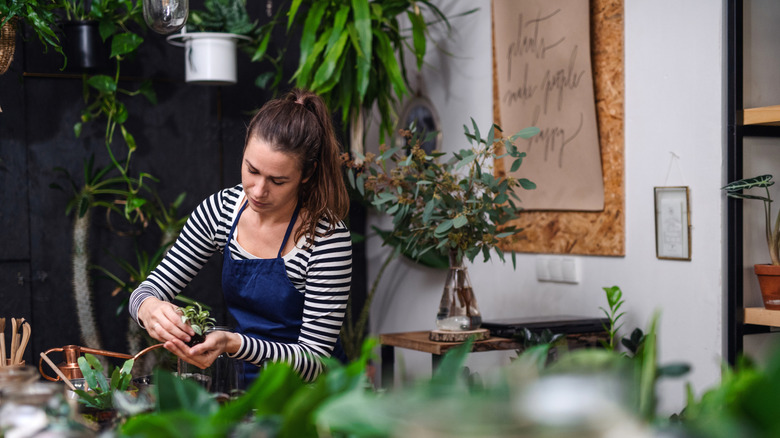Turn A Basic IKEA Cabinet Into A Stunning Terrarium For Your Home
Bringing the outdoors in can lead to a calmer, more tranquil space. This means incorporating lots of plants, natural materials, and biophilic interior décor elements into your home. The internet has recently been filled with tutorials showing you how to create stunningly large terrariums, many of which modify existing IKEA cabinets. These cabinets are often a budget-friendly option for creating dedicated enclosures for terrariums and indoor greenhouses. With just a few modifications, you can make any IKEA glass-fronted cabinet into a wild, green wonderland for your plants.
This DIY works with many different cabinets in the IKEA aisles, including the MILSBO, BLALIDEN, FABRIKOR and BAGGEBO, all of which feature glass-fronted doors and range in price from $50 to $250. You can leave these cabinets in their original finish or spray paint them to match your décor. You could also paint the interior a darker color like black, dark green, or brown to give some depth and pop against the greenery.
Modifying an IKEA cabinet to create a terrarium
To convert an IKEA cabinet into a terrarium, you will need certain additions, including a base composed of gravel, pebbles, soil, or mulch (which one works best depends on what you intend to grow). To keep this loose matter in place, firmly attach a plexiglass panel in the front across the bottom of the cabinet using a watertight adhesive.
If you would like to add a grow light, drill holes for the electrical and mount it to the inside top. You could also cut holes to allow natural light in from above. If you plan to keep living creatures in your terrarium, you may also want to add wire mesh over open areas for proper air flow. For a final step, insulate your cabinet with silicone caulk or weather stripping along the doors to maintain consistent moisture and temperature levels, as well as prevent any leakage on the outside from watering or humidity.
Decorating and maintaining your terrarrium
Adding natural elements to the terrarium helps create the environment necessary for growth. You can use different types of terrarium plants including fillers like moss, lichen, and fungi. While there are many different kinds of terrariums and environments, other additions beyond plants that contribute texture and depth include wood branches or stumps, rocks, shells, decayed matter, sand, crystals, and seed pods. You can even add insects or worms to help maintain the environment. Many pet owners create terrariums to house reptiles and amphibians as well (just make sure your adhesives and materials are animal friendly).
Most terrarium owners mist their small ecological environments at least once a day to maintain necessary moisture, though you could also install an automatic mister on a timer directly in the cabinet that attaches to the top of the enclosure. Regular maintenance includes wiping down the glass, checking humidity and temperature levels for optimal growth, and cleaning out any debris that hinders the environment.
